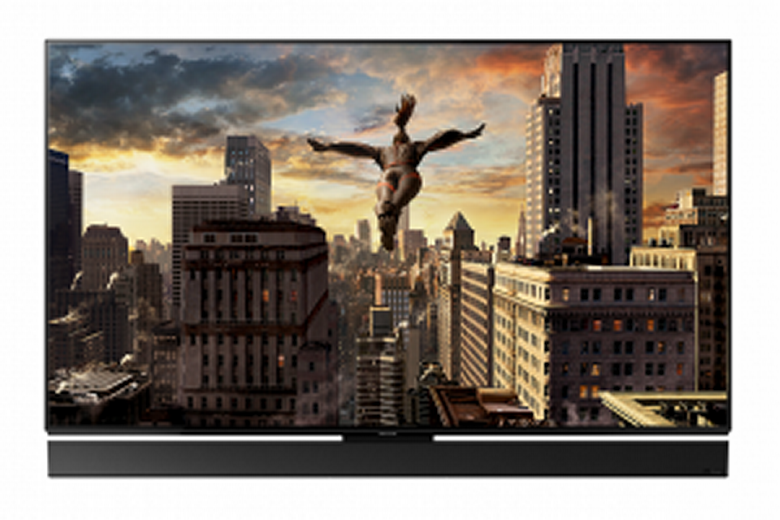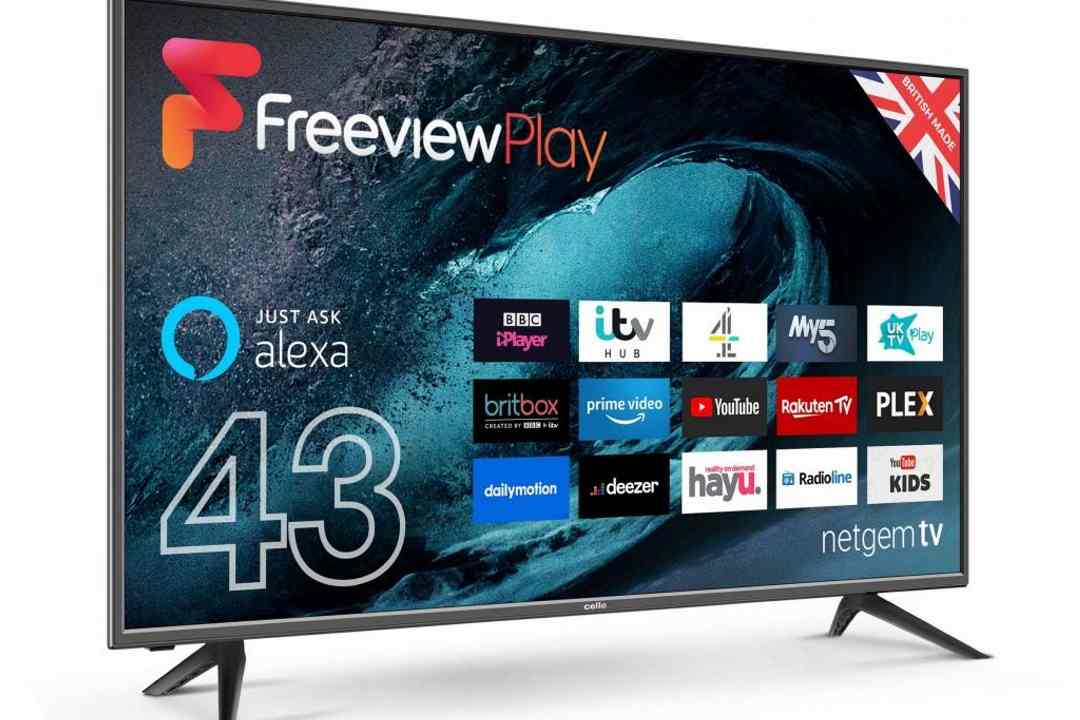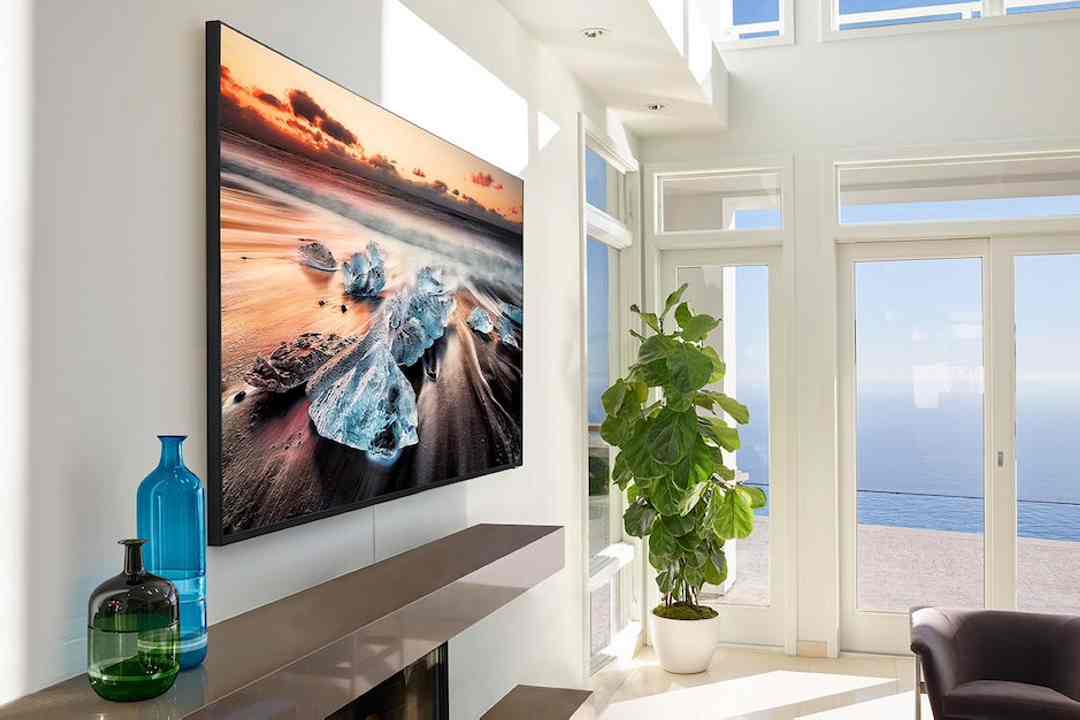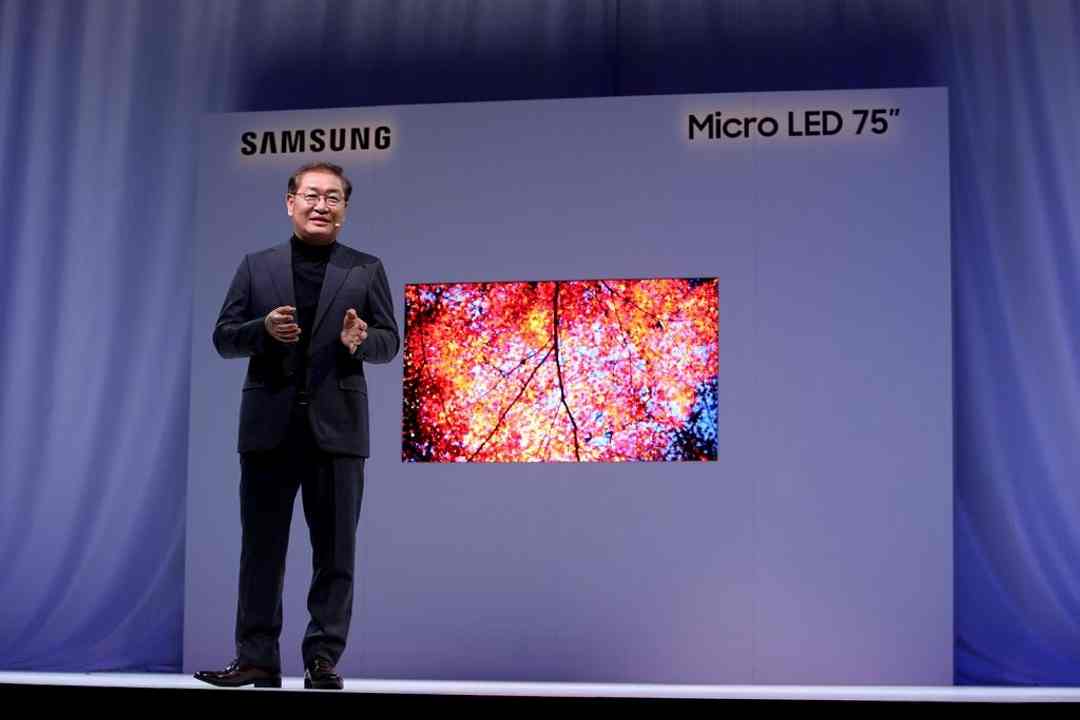
You’ll struggle to find better for the money.
Pros
- Gorgeous, accurate pictures
- Powerful sound
- Good smart interface
- Good app support
- Light-up remote
Cons
- Some of the menus could use a facelift
Key Specifications
- Review Price: £2499
- Ultra HD resolution
- HDR: HDR10, HDR10+ and HLG
- 4 x HDMI
- Integrated soundbar
What is the Panasonic FZ950/FZ952 OLED?
The 2018 flagship TV party is well under way, and Panasonic is the last of the big four manufacturers to arrive. But you know what they say about good things and those who wait. The Panasonic FZ950 series OLED is a very good thing indeed.
We’ve already seen some top-tier performances this year: the Samsung Q9FN, Sony AF8 OLED and LG C8 OLED are all jaw-droppingly good in their own ways. And then Panasonic rocks up with a product just as good – better in some respects – plus aggressive pricing to match.
If you’re a film fan and picture fidelity is important to you, this 4K OLED TV will make you very happy.
Note that this television is known as the Panasonic FZ950 series in Europe, but in the UK it’s called the Panasonic FZ952. Tested here is the 55-inch version (full name, Panasonic TX-55FZ952B, tested here), priced at £2499 at the time of review. There’s also a 65-inch version (Panasonic TX-65FZ952B), which costs £3999.
Related: Best TV
Panasonic FZ950/FZ952 OLED – Design
Anyone familiar with last year’s EZ1000 series will be right at home here. The Panasonic FZ950/FZ952 is an obvious descendant, with almost the same design elements.
A third of the device is just screen, no thicker than a stack of six credit cards. The bottom two-thirds of the screen is backed by the housing for the electronics, which takes the thickness to just under 5cm. Below that is a pedestal type stand that’s mostly a soundbar – the Dynamic Blade speaker, tuned by Technics.
The only obvious difference is that the Panasonic FZ950/FZ952 is a little less bling. The neck connecting the TV to the base is all black and tucked behind the soundbar, as opposed to a column of attention-seeking chrome. The neck is also a lot wider, which I presume is for stability reasons. It works.
The Panasonic FZ950/FZ952 ships with two remotes. There’s a traditional face-full-of-buttons slab and a minimalist Touch Pad Controller.
For the traditional approach, Panasonic’s offering is easily the best. The metal faceplate makes a premium first impression. Everything is nicely spaced and clearly labelled. There are dedicated buttons for key apps, including a very helpful that you can assign yourself.
Then there’s the light button, which allows for dark-room button-pressing. To my knowledge, none of the other big TV manufacturers offers backlit remotes. 50 points to Panasonic.
Ironically, the more modern-thinking Touch Pad Controller is the one I really don’t get on with. Its banana-like curve isn’t nearly as ergonomic as Panasonic thinks it is. I can embrace the barebones approach to buttons; I can’t get used to the swipey control scheme, which is fine for touchscreens but has no business on a remote. The traditional wand is more useful and intuitive.
As for connections, you’ll find four HDMI sockets (one HDMI ARC) and three USB ports at the back. Note that HDMI ports 3 and 4 aren’t full-bandwidth – they can play 4K at 60Hz or 50Hz, but chroma will be capped at 4:2:0. The vast majority of you will be unaffected – two is enough – but serious AV nerds should note the Samsung Q9FN and LG C8 each offer four full-fat ports.
I was also pleasantly surprised to see full-sized component/composite inputs, just in case anyone wants to break out a vintage games console ahead of the inevitable N64 Classic Mini release.
Related: Netflix vs Amazon Video
Panasonic FZ950/FZ952 OLED – Software
Panasonic’s My Home Screen 3.0 interface is a good one. Built on Mozilla’s Firefox TV OS, it’s minimalist and customisable.
Press the home screen, and a menu pops up, sitting on top of whatever you’re watching without interrupting it. This menu is populated with the apps, channels and inputs of your choice. It’s not quite as slick as LG’s WebOS equivalent, but it is cleaner.
While I like the smart TV menu elements, I should point out Panasonic’s menu systems elsewhere are starting to look a bit dated. Going through the settings and TV guide, I couldn’t help noticing the boxy options and fonts look no different to how they were when I first started reviewing TVs six years ago. It’s not critical, but an update couldn’t hurt.
App support is bang up to date, which is the most important thing. You get the 4K and HDR versions of the Netflix, Amazon Video and YouTube apps. There’s also Freeview Play, which ensures you get the full suite of the UK’s terrestrial catch up apps: BBC iPlayer, ITV Hub, All 4 (formerly 4OD) and Demand 5. The only one I missed was Now TV.
Related: Best Streaming Sites
Panasonic FZ950/FZ952 OLED – Features
As is expected of a flagship TV, the Panasonic FZ950/FZ952 OLED has a 10-bit panel with an Ultra HD 4K resolution (3840×2160 pixels) and support for high dynamic range (HDR).
Compatible HDR formats include the standard HDR10 that everyone is using, plus the broadcaster-friendly Hybrid Log-Gamma (HLG). HLG is generally seen as future tech but I can confirm it works right out of the box, with no need for a firmware update.
I was able to receive a BBC iPlayer 4K HLG stream of a World Cup 2018 game – Portugal v Spain – from both the native app and a Roku Streaming Stick Plus.
Then there’s ‘dynamic metadata’ HDR, which lets the TV optimise the picture scene by scene. This is another key advantage of the Panasonic FZ950/FZ952 over last year’s EZ series – the second generation HCX processor can handle dynamic metadata.
It doesn’t support Dolby Vision, but it does support HDR10+. Dolby Vision came along first, but HDR10+ is gaining momentum since it has the support of Panasonic, Samsung, Amazon, Fox and Warner Bros.
Personally, it doesn’t feel like having either format can be deemed an advantage or a weakness. That’s because it is too early to say which format will become dominant. At this stage, I wouldn’t recommend anyone buy a TV specifically for Dolby Vision or HDR10+. There’s just not enough content and support out there to make this a deciding factor.
Right now, the important thing is that a TV handles the basics right, which means making the most of the good old standard HDR10. To that end, Panasonic has seriously upgraded its approach to its lookup tables (LUT), the maps that tell TVs where to put certain colours. This year’s have more layers, which translates to greater precision in colour handing.
They’re also dynamic now, where LUTs are usually static. Translation: the TV’s tone-mapping abilities now react to a picture’s luminance. The picture is constantly analysed, with new LUTs constantly generated every 100 milliseconds. In theory, that means improved accuracy in the midtones and highlights, where OLEDs have traditionally struggled against LCD TVs.
Panasonic FZ950/FZ952 OLED – Picture performance
Whatever wizardry Panasonic has thrown at the FZ950/FZ952, it absolutely works. This is one gorgeous television. There are so many things to praise and I don’t know where to begin, so I’ll do it alphabetically.
The blacks, then. OLED TVs have long been able to reach absolute black levels, but Panasonic has really been working on fine detail in the areas just above black, and it shows. In The Last Jedi, in the shadows of indoor scenes on the planet Ahch-To, I noticed textures on Luke’s robes that I couldn’t make out on the LG C8.
Panasonic’s better dark detail is one reason for this; another reason a lack of the picture noise, which sometimes pop up on the LG. In this department, I’d say Panasonic is on par with the Sony AF8 OLED.
Related: Best TV deals
On the opposite end of the scale is brightness, and the Panasonic FZ950/FZ952 hits a peak of about 785 nits, which is a little shy of the 800 or so on the LG. With the TVs placed side by side, I could consistently see the LG is a little brighter, but there’s really not much in it. I wouldn’t use this factor alone to make a buying decision.
Both are comfortably more impactful than the Sony AF8 and Sony A1 OLED TVs, which hover about 700 nits – fine but still better suited to darker rooms. If you want a really bright TV for a bright room or daytime viewing I’d still recommend the Samsung Q9FN, but otherwise what the Panasonic offers is enough.
Peak brightness is all well and good, but it’s what you do with it that really matters. I reckon the dynamic LUT system does its job because the FZ950 has excellent control of highlights. I spend a lot of time watching shiny cars on Amazon Video’s The Grand Tour, and the Panasonic does a fantastic job with bright sunlight glinting off metal.
Specular highlights have a proper kick to them, enough to make you squint, while making sure a lot of the detail doesn’t get clipped. The FZ950 also looks slightly less forced with very bright colours, when compared with the LG.
Speaking of which, the FZ950’s colours are lovely. Like the Sony AF8, Panasonic’s approach values accuracy over impact and look more convincing for it. They’re vivid and nicely saturated, but restrained enough to avoid giving an unnatural look to grass, skies and skin tones. Shading is subtly done too. I did notice a little banding in dark grey test patterns, but I couldn’t see anything in real use.
The LG C8’s colours are bolder for sure, which is more easily impressive at a glance, but look at the pictures side by side for more than half an hour and it’s apparent that Panasonic has a better balance. It’s harder to tell with sci-fi films but put on something real, such as Planet Earth II, and the FZ950’s subtlety becomes apparent.
Motion handling is excellent, too. The yellow opening crawl from The Last Jedi ran more smoothly here than on the LG C8, which demonstrated a little more judder. It’s the same with action scenes and camera pans.
It’s not quite up there with the Sony AF8 and Sony A1 OLED’s levels of motion fluidity, but it’s not far off. I rarely felt the need to turn on additional motion processing, and when I did the effect was subtle.
Whether you watch 4K or upscale a 1080p picture, the picture is wonderfully sharp. There’s plenty of definition, but not so much that things look overly processed. LG has clearly gone for the bolder approach and looks crisper for it.
Panasonic has again gone for subtlety, with the level of sharpness appropriate for different images. Rocks and buildings are cleanly and starkly drawn, while fur or creases in fabric look softer. Again, a natural look.
Uniformity is one of OLED’s strengths, since the panel can control light right down to pixel level. It’s physically impossible to have any of the halo or blooming effects evident on even the very best LCD TVs. You can have extremes of light right next to shadows and there won’t be any light pollution. There’s also no sign of the vignetting effect – earlier OLEDs were prone to darker picture edges.
Finally, viewing angles. As with uniformity, this is another key advantage that OLED has over LCD TVs. You can sit anywhere you like and watch the TV from any angle without fear of desaturation or loss of brightness.
Panasonic FZ950/FZ952 – Audio performance
This TV doesn’t just look great, it sounds great. That’s thank to the Dynamic Blade speaker, tuned by Panasonic Corporation’s Technics audio branch. There’s plenty of power and dynamism, enough to handle the demands of big movie soundtracks.
Tonal balance is good, although you can adjust it to your liking. By default, dialogue is clear and full-bodied, and there’s enough bass where it’s called for.
I’m usually sceptical of surround sound modes, but the ‘Cinema Surround Pro’ setting actually does a great job. It opens up the soundstage to make the sound a lot ‘bigger’ than the TV’s dimensions, and sound effects placement is impressive.
My default setup is a large pair of stereo speakers, but I felt happy enough with the FZ950’s sound that I didn’t feel the need for audio reinforcement. If you have an old TV, and you’re upgrading without an existing sound system, the FZ950 is a good all-in-one device.
Related: Best soundbars
Panasonic FZ950/FZ952 – Settings
Panasonic takes settings extremely seriously. If you’re an AV nerd and you want to spend a whole weekend tweaking every little aspect of the picture – or you’re a professional picture calibrator, Panasonic’s toolbox guarantees a good time. Most people, however, will be happy with a few basic switches, without diving into the advanced settings part of the menu.
First up, the picture mode. I liked a custom version of the Normal preset, since this is the one with enough brightness to satisfy my HDR hunger – True Cinema is the most accurate, technically, but I’d save that for black room viewings.
In Normal mode, change the colour temperature to Warm1, since the default is a little too cold/blue. Leave Vivid Colour on for standard dynamic range but off for HDR. Colour Remaster (or Rec.2020 Colour Remaster in HDR mode) should be left on minimum.
The HDR Brightness setting is useful. HDR Auto Brightness is a good way to deal with changing lighting conditions. HDR Enhancer is good for finetuning the HDR impact.
Intelligent Frame Creation is the extra motion processing, which I generally found unnecessary but can be left on minimum without messing up the picture.
Last but not least is game mode, which you’ll want to turn on for low-latency gaming. The Panasonic is among the fastest out there at about 21ms of input lag. That’s obviously better than the 30-45ms I recorded on the Sony AF8, but not quite as fast as the Samsung Q9FN at 15ms.
Why buy the Panasonic FZ950/FZ952?
Having been around TV manufacturers for years, I can tell you I’ve lost count of the times I’ve been told a TV fulfils ‘the director’s vision’. It’s nearly always hyperbole and I’ve trained myself to ignore it. But with the Panasonic FZ950/FZ952, I can genuinely believe it.
That’s got nothing to do with the Hollywood colourists I’ve visited, who use these TVs in their mastering studios. That’s just down to my own eyes, and what I see is a beautifully natural picture full of refinement and subtlety, yet capable of just enough impact for mainstream tastes.
What you have here is the best of all the OLED worlds I’ve seen so far in 2018: the Sony AF8’s delicate approach to colour, fine detail and motion, plus the LG C8’s affinity for visual impact, user-friendly software and fast-response gaming. If you’re after an OLED in 2018, I think this is the complete package. Great job, Panasonic.
Like what you see but don’t need a soundbar? Then check out the Panasonic FZ802/FZ800 OLED, which trades the soundbar for a smaller price tag while retaining the same gorgeous picture.
If you’re not in a hurry, I’d suggest holding out a little, however. Sony’s just announced the Sony AF9 OLED, and that’s bound to give Panasonic a few things to worry about. You can read more about the new Sony TVs here: Sony’s new Master Series 4K TVs could be the ultimate way to watch Netflix.
Verdict
Panasonic is back on top form. You’ll struggle to find better for the money.
How we test televisions
We test every TV we review thoroughly over an extended period of time. We use industry standard tests to compare features properly. We’ll always tell you what we find. We never, ever, accept money to review a product.
Find out more about how we test in our ethics policy.
Used as the main TV for the review period
Tested for more than a week
Tested using industry calibrated tools, discs and with real world use
Tested with broadcast content (HD/SD), video streams and demo discs







